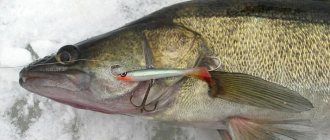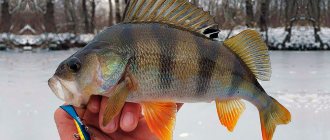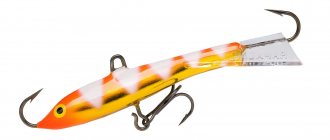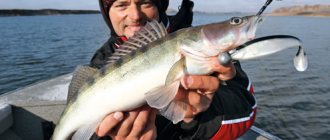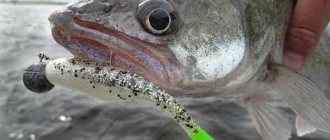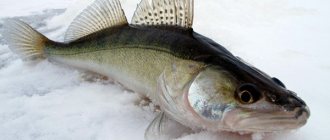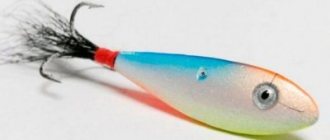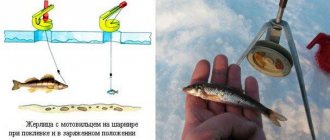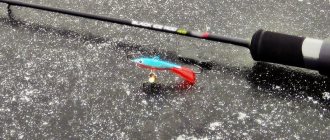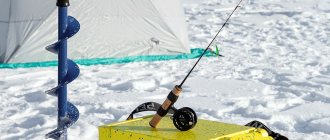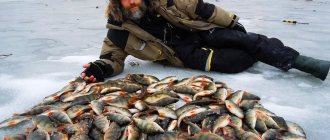What is a balancer
This is an artificial bait of different sizes, for vertical trolling. To put it simply – a small fish made of metal. She has a heavy body and tail, so she maintains good balance - she is always in a horizontal position.
Thanks to the plumage, the artificial fish swims in the water, scouring from side to side, just like a real one. There are two single joints in the tail and head parts of the product, and a tee in the lower part. Experienced fishermen advise choosing a larger bait for pike perch.
Top 5 balancers for zander
Now let's try to identify the best balancers for pike perch. The following baits show stable results on various types of reservoirs:
Rapala Jigging Rap
The balancing act is almost flawless. It is used by many sports anglers, especially in the 5 cm size.
Kuusamo tasapaino x
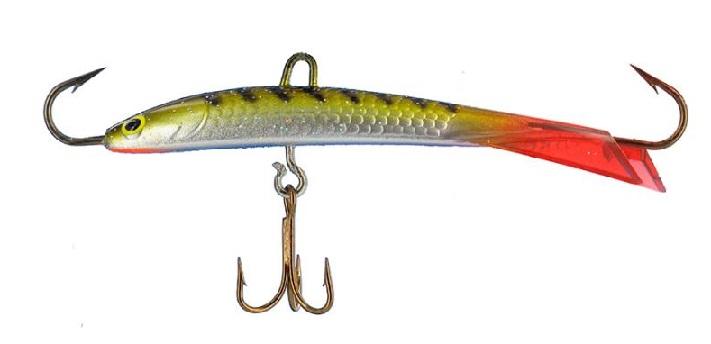
A universal balancer weighing 18 grams and 78 mm long, can be used at any depth. The bait is universal and catchy, thanks to its sweeping action in a stable position. With it, high-quality animation is possible even in strong currents.
Scorana Ice Crystal Mark 2
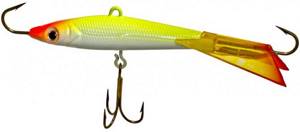
The bait weighs 32 grams with a body length of 80 mm. It is distinguished by measured and stable work. Performs well in currents and great depths. In addition to pike perch, pike often “sits” on it. To avoid offensive losses, it is better to use a thin metal leash. Scorana ice mark 2 is one of the best budget balancers for catching trophy fish.
Nils master rotinkainen
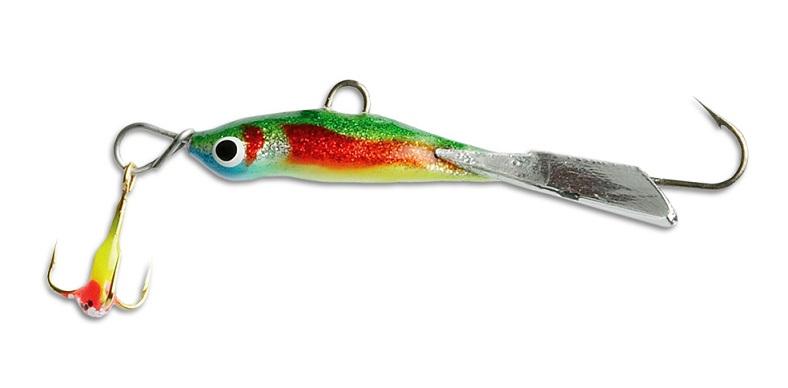
This model is suitable for catching predators in two ways. In a horizontal position, the bait is used as a regular balancer. By attaching the cord to the hook in the tail, you can fish with the bait in a vertical position, like a vertical lure.
Lucky john pro mebaru
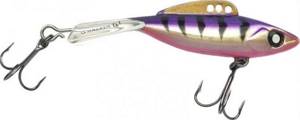
Lucky John balancers are a good Latvian development, designed for catching predators from the ice or in a plumb line. You can use three types of games. Two tees will not give a chance for pike perch. The design of the bait does not have a nose hook, which minimizes snags in places where snags accumulate.
How to determine the ideal time to fish
For fishing to be successful, it is important to determine the fishing conditions. Pike perch is most active at night; it hunts small fish thanks to its excellent vision. The sharp eye of a predator is able to locate even the smallest fish in complete darkness.
It is not easy to predict whether catching pike perch in winter using a balance beam will be successful. Having swallowed food, it sinks to the bottom in order to digest it. A good bite is observed in the evening/night or early morning - it is easier for a predator to hunt during these hours . During the day the catch is much smaller.
Balancer selection parameters
Counting on a good catch, you need to understand which balancer should be used and in what situation. The choice of balancer is based on the following criteria:
- size and weight;
- color;
- manner of play, depending on the plumage and the location of the tail wing.
Let's look at each point in more detail.
Size
Catching pike perch in winter with balance beams is carried out at fairly large depths, which sometimes reach 15-20 meters. Based on this, the bait should be chosen very large and heavy so that it can easily reach the bottom.
|

In shallow water, balancers up to 7 cm long and weighing up to 20 g are often used. Deep areas require the use of bait from 7 cm in length and from 15 g in weight. Although one of the most important advantages of a balancer is the ability to use it in different reservoir conditions.
Color
The selection of a balancer for this parameter should be based on shade rather than a specific color. In deep layers it is recommended to use bright bait with acidic tones. Closer to the surface of the water, dark patterns come into play.
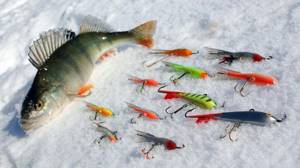
The most catchy color of a balancer for pike perch in winter is considered to be the one that matches the color of a perch or roach. It is also worth paying attention to the color of the abdomen. Red or acid orange is considered optimal.
To save money, experienced fishermen recommend purchasing alcohol-based markers. With their help, you can literally change the color of the bait in just a few minutes. You can return the balancer to its original appearance by wiping it with a cloth soaked in alcohol.
Plumage
Until recently, all baits of this type had a plastic wing, but now balancers with feathers have begun to come into use. In general, according to this criterion, models can be divided into three types:
- Lobed. They are distinguished by the presence of a plastic wing in the tail section, which, depending on its shape and location, affects the play of the bait during diving and retrieving. This type of balancer gives excellent results at times of increased activity of pike perch under the first ice.
- Bladeless. Such balancers for pike perch (see photo) in the tail part have a tassel consisting of hard threads or fur. The playing style of this bait is smooth. The amplitude here is much smaller than in the previous version.
- Combined. As the name suggests, such models have both a plastic wing and down feathers. They are used at a depth not exceeding 10 meters and show good biting results, even though they were originally designed for catching perch.



Game check
Even if you select the balancer as correctly as possible for specific fishing conditions, you should carry out a preliminary check. It is better to do this in advance, before the water becomes covered with ice. So, having got to the place, you can personally observe the game of the bait and its behavior at the moments of various retrieves.
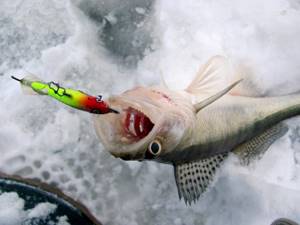
If freezing has already occurred, then testing is carried out at home in the bathroom. The best wiring should be memorized in order to use it in practice later.
Where to look for a predator
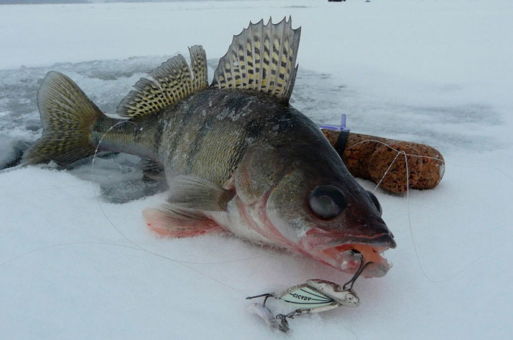
Finding this fish under a layer of ice is not so easy: you have to go far and drill many holes. If you managed to find even 1 pike perch, successful fishing is guaranteed! Your “client” will lead you to his pack.
On the way to your pike perch, you need to make more than one hole in the ice, and you don’t need to stay at each one for more than 10 - 15 minutes: if there’s no bite, there won’t be one. Remember that time flies faster in winter, so it's better to speed up. Most often, pike perch can be found in the following places:
- in reservoirs with holes at the bottom;
- where it is very deep;
- on edges and slopes;
- where there are a lot of snags, fallen and flooded trees.
Fish loves deep and dark areas, for example, dumps that go into the depths. The most favorite “locations” are a rocky bottom, with a sandy or hard base. If you have not previously studied the nature of the reservoir, finding this beauty will be difficult, and sometimes impossible.
Select “promising” areas and drill holes. The balance beam should not be raised more than half a meter - pike perch lives at the very bottom, rarely rising outward.
How to choose a balancer
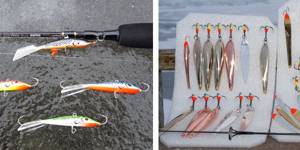
There are no special rules for choosing artificial bait: it is important to simply understand how to use it correctly. You should not buy a balancer from a cheap category - choose a catchy, high-quality product from a well-known manufacturer.
The best accessories will help you learn how to fish in winter conditions; even a beginner can use them. If the product is of poor quality, the play of the balancer may be disrupted, which affects the catch. To catch pike perch, it is recommended to use a bait of at least 7 cm, since small ones attract perches and smaller fish, and very large ones will not fit into the hole.
Dimensions
Expert opinion
Valery Andreevich Sizov
Professional fisherman with 35 years of experience
Since pike perch prefers deeper areas in winter, from 8 to 15 m, the bait should not only be large, but also heavy. The average weight should be at least 10 grams, and sometimes it is important to use products of 40 – 50 grams.
The best option for greater depths, from 15 m and more – 30 – 50 grams. It is definitely worth considering the flow: the balancer must be positioned stable and not spin around its axis. His playing should be smooth, without sudden movements or jerks. This product is only suitable for weak currents.
It is best to catch pike perch using large baits. Fishermen have noticed that even small fish willingly bite on large balancers. Artificial fish with a length of 7 cm or more are considered to be the most catchy. At greater depths - from 10 cm, only if there are trophy pike perch .
In the middle of winter, the predator behaves passively and sluggishly, so you can use small baits, from 5 cm.
Catching Pike-perch in Winter on Balancer: Tackle
A winter fishing rod for pike perch should be as rigid as possible, and about 30–50 cm long. Since pike perch is mainly worth catching at depth, even a very slight current will blow an arc out of the line, and monofilament line doesn’t stretch well. Therefore, in order for the pike perch to be thoroughly hooked, the hook must be done with a sweeping and whipping movement of the hand.
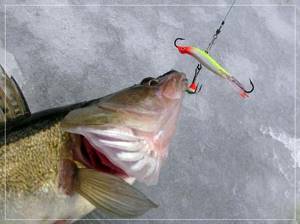
The selection of fishing line for pike perch is also not so simple: The diameter of the fishing line should be selected according to the fishing conditions. Everyone knows that the thinner the line, the less windage it has. But it stretches much better than thick ones.
And, the thicker the line, the greater the windage, but almost no stretch. So here you should choose a middle ground, which is why you need to select a fishing line for certain fishing conditions. I think that the most optimal diameter will be 0.25-0.32.
Let us not miss to say a few words about braided cord. I would not use braided line at greater depths.
When hooking and retrieving, it is almost impossible to carefully lay the braid on the ice. In the cold, it begins to stick to clothes, and I’m generally silent about getting tangled. So the choice is yours.
Now about the coils . We tried both inertia-free and multipliers, but settled on the best: our own hands))).
3 ways to improve your fish bite!
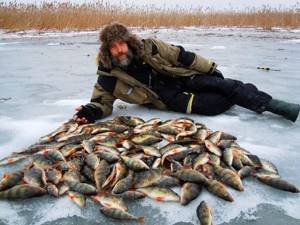
Over 15 years of active fishing, I have found many ways to improve the bite, and here are the most effective:
1. Bite activator . This pheromone additive attracts fish most strongly in cold and warm water. The Fish Hungry bite activator has proven itself to be excellent - Read more…
2. Tackle with increased sensitivity . You should first familiarize yourself with the features of using a particular type.
3. Pheromone baits . They attract the attention of fish, stimulate hunger and cause a schooling reflex, which allows you to collect a lot of fish in one place.
You can get the rest of the secrets of successful fishing for free by reading my other materials on the site.
3 ways to improve your fish bite!
Over 15 years of active fishing, I have found many ways to improve the bite, and here are the most effective:
1. Bite activator . This pheromone additive attracts fish most strongly in cold and warm water. The Fish Hungry bite activator has proven itself to be excellent - Read more…
2. Tackle with increased sensitivity . You should first familiarize yourself with the features of using a particular type.
3. Pheromone baits . They attract the attention of fish, stimulate hunger and cause a schooling reflex, which allows you to collect a lot of fish in one place.
You can get the rest of the secrets of successful fishing for free by reading my other materials on the site.
Fishing is much faster, and there are much fewer fish drops than when using a reel to collect fishing line when hooking. I think many anglers will agree with me.
Therefore, it is worth staying close to those gymnasts who are actively waving their arms in the form of collecting fishing line from the hole))). There's probably fish there too. This applies to a greater extent to those bodies of water that you do not know well.
Pike perch on the Balancer in Winter. Tackle and Lure (Video)
Shades and features of plumage
The shade of the bait can play a role: when it is cloudy, it is better to choose bright and light fish, and on a clear day - dark colors. You can look at colorful products with bright and muted colors at the same time. As for plumage, the range of products is divided into two categories: bladed and bladeless.
The former are suitable for working on the first and last ice, with high fish activity. The second is in a passive and lethargic state of the predator. The color and design of the product affects its effectiveness; it is also important to pay attention to its game and shape - they can interest pike perch.
The fact is that the balancer sinks to great depths, and the predator will be attracted by the shape and movements of the potential prey - the fish. Fishermen do not use the same type of balancers - pike perch may not bite on the same bait. It is necessary to change the design of the bait, color and shape.
There are combined options: in part of the tail there is a blade and plumage. They work well with passive pike perch.
We recommend watching this video:
About tackle and bait
The required set for ice fishing includes the necessary gear, bait, drill and alarm case. The main emphasis is not only on bait. It is necessary to carefully select a rod, fishing line, reel, and check the condition (sharpness) of the hooks. Read more about choosing a fishing rod and accessories below.
Fishing rod rig
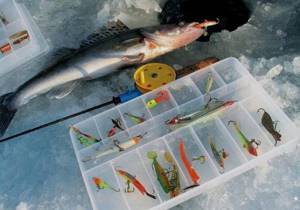
In this case, we are talking about winter fishing for fanged fish; a soft nod will not work effectively. The result of its use is unnatural operation of the bait. And also an increase in the number of fish that are poorly detected.
Fishing line: optimal diameter – 0.25 mm.
Important. When fishing for pike perch on a balance beam, at a depth of over 10 meters, it is definitely better to replace the fishing line with a braided cord. Even a relatively thick fishing line has stretchability and will blur bites and make hooking difficult.
The leash is placed at the personal discretion of the fisherman, although many ignore this element. Reason: You can scare away the fish. Usually they focus on the probability of a pike biting, which will immediately cut through any braided line. But a supply of fishing line must be present. Fishing often takes place in “strong” places. From time to time, dead hooks occur, forcing you to tear the line, which, of course, reduces its reserves.
We recommend reading: Winter fishing for bream on a float
On a note! In most cases, a simple device will help to save fishing line and catchable baits - a detachment. This assistant takes up minimal space and should always be taken with you.
The sharpness of the hook is very important. The effectiveness of hooking a predator with a bony mouth depends on its sharpness.
Dimensions and shapes of winter balancer
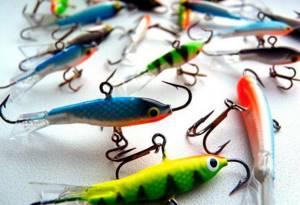
Due to the fact that the search for pike perch is carried out at a depth, and this is often 15-20 meters, you need to select a weighty balancer that can quickly reach the bottom of the reservoir. You can work with the universal 7 cm model and experiment. If necessary, you can put “eight” or “nine”.
There are several variations of artificial baits on sale:
- Blade models. They are distinguished by the presence of plastic wings glued to the tail, with the help of which an attractive game is created. Their catchability can be assessed by the first ice.
- Bladeless designs. At the back, such models are equipped with a tassel made of rigid threads. The design is characterized by smooth, measured play. They work well in the middle of the winter season, when the predator is not particularly active.
- Combined options. It is a hybrid of the two previous versions, which have blades and tails. They are best used at depths reaching 10 meters.
Armed with this data, you can combine and select an artificial bait that works well.
Catchy colors
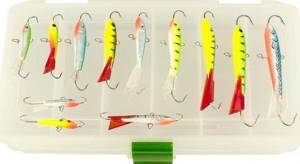
The choice of bait color haunts experienced fishermen and novice trophy hunters. It is difficult to adequately select gear due to refraction (distortion) of color at depth. For example, balance beams of bright red colors look dull at around 7-10 meters.
Many people have a personal opinion about the catchability of color and make an appropriate choice. Lures that are effective killers of pike perch are:
- Red fish with a yellow belly.
- Dark blue designs: with silver back.
- The bait is poisonous yellow.
- Saltan color.
- Silver models.
Note! Pike perch clearly sees potential prey at a depth of 12-15 meters. The color of the bait itself does not matter. With the help of “long-range” colors you can help the pike perch find it a little faster. Seeing a suitable object, the fanged one attacks without delay.
We recommend reading: The best lures for asp
Experiment, install balancers with light-accumulating paint. In the shallows and medium depths, the colors show themselves worthy: “a la” bleak, roach. The color of the hooks doesn't really matter.
Remember, the colors can be easily changed on the pond by taking multi-colored markers with you.
Refinement of hooks
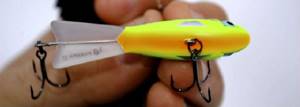
Therefore, the issue of hook sharpness is always relevant. They can and should be improved. You shouldn’t save money, it’s better to buy products from well-known manufacturers like Owner: this is my personal opinion. An irritant element is often mounted on the tee: a tail, a tassel, a bead or a strip.
On a note! Increased hook weight is normal. The action of the bait with the load becomes incomprehensible and sluggish, which often provokes the pike perch to attack.
Gear selection
For fishing to be successful, you need to prepare - purchase a strong fishing rod and the best gear. If a bite occurs, you need a good hook; using a soft nod will not withstand the rough and very strong jaw of this fish.
Expert opinion
Valery Andreevich Sizov
Professional fisherman with 35 years of experience
The hook must be confident and powerful. To complete the gear, you need a fishing line with a diameter of at least 0.25 mm. You don’t have to use a leash - the pike perch will bite the line. In addition, this may alert a predator. The fishing line should be with a reserve, since you will have to get the fish from great depths.
Keep your hooks sharp - if they become dull, sharpen them. Only the middle tee needs to be replaced - this is how the balancer is designed.
The fishing rod must be rigid, elastic and durable. The optimal length is up to half a meter or more. If the balancer is light, equip it with a rigid nod made of spring steel. Dacron up to 5 cm long is suitable. As for the reel, you can use three types for ice fishing:
- Inertial.
- Inertial, with large diameter drums.
- Inertia-free.
Animators are also suitable. Small-diameter reels are suitable for holding fishing line, but they are not used for pulling out a catch or reeling in fishing line. Thus, you will have to pull the thread onto the surface of the ice.
A mandatory attribute is a guard at the end of the rod . Sometimes it is difficult to recognize a bite while holding the fishing line in your hands, as the fish behaves very carefully. The guard is made of a metal plate, with a small bright ball at the end. In its normal position during fishing, the guard can deviate by 45 degrees. Tackle such as braid is completely excluded - it is absolutely not suitable for winter fishing. It is recommended to use one line.
During the fishing process, the guard should not spring, otherwise a good game with the bait will not work. The best option is silicone tubes, which can withstand frost and sudden temperature changes. You can make lavsan springs or nods like springs. For beginners, it is important to purchase a leash against the teeth of the pike - this is important, because you can lose a catchy, expensive balancer. The leash can be made of fluorocarbon - a well-suited option for this breed of fish.
Rules for fishing using a balance beam
Experienced fishermen claim that the basis of working with a balancer is a pause of varying lengths. If you take short breaks during the fishing process, the predator will give itself away if it is somewhere nearby. The average duration of pauses is from 20 seconds to 1 minute. When the balancer performs a series of movements, you should take a break. Without such breaks, even with excellent performance of the bait, the fish will not be interested in it. The predator attacks at a moment when there is no movement.
In winter, during periods of low fish activity, do not make wide, sweeping movements - the emphasis is on short jerks, no more than 15 cm long. The movements should be repeated for 2 minutes. Use different tactics at one hole, and if there is no result, start working on another hole. There are many peculiarities of fishing using artificial fish; everyone develops their own. For example, it’s good to fish if you slowly and smoothly raise and lower the product into the hole. You can touch or not touch the bottom - if the pike perch is nearby, it will react.
During the process of raising and lowering, make small or small to medium movements as if you were walking on steps. When you tap on the bottom, you will be able to lure fish that are far away - predators are great at picking up vibrations. Thanks to its keen vision, the pike perch will also notice a cloud of turbidity rising from the bottom. When the pike perch is hungry, it rises higher to see if there is any bait nearby.
If you notice a bite at depth, raise the balancer higher and change your movements. This happens often during warming periods.
You should allocate no more than 10 minutes per hole. The faster a fisherman looks for a pike perch site, the higher the chance of catching a great catch. If you notice a bite, try fishing in the nearest holes - the habitat of the fish can be located at a distance of 10 - 20 meters. The main thing is not to scare off the fish, otherwise it will go to look for food in other places.
Where to catch pike perch on a balance beam in winter
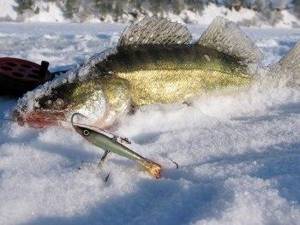
The first thing you need to do is figure out how to find pike perch, find out which areas of the reservoir can be considered promising for catching this predator, and in which places it is pointless to look for fish.
To find pike perch, you often have to drill a large number of holes. Each hole not only serves as an attempt to catch a predator in it, it will also tell you about the nature of the bottom and changes in depth, which is very important when catching a fanged one.
With each subsequent hole, watch for changes in depth. Pike perch is most often found in holes or on the edges; it loves sharp changes in depth, where it prefers to be almost at the very top point of the hole, that is, at the exit from it. This fish also loves a hard bottom, mainly sandy or rocky. It tries to avoid muddy bottoms in winter and is extremely rare in such areas of the reservoir.
So, based on the above, we can conclude that in winter you should look for pike perch in the following places:
- areas of a reservoir with a hard bottom - sand, stones, etc.;
- holes, depressions in the bottom topography, dumps;
- edges, exits from pits;
- stuck areas of a reservoir with great depth.
If there are any shelters at depth - snags, flooded trees, boats, etc., then there is a high probability that the pike perch will use such places for shelter.
It is worth noting that pike perch, like perch, is a schooling fish, so catching it is made easier by the fact that if a bite occurs, then it makes sense to fish the same hole further or drill subsequent ones in the immediate vicinity of the one in which the bite occurred.
A place where you managed to catch several specimens at least once should be remembered. Pike perch often moves along a reservoir along the same route, so most likely it will bite in the same place all winter at certain times.
Having found several such places and determined the biting time at each of them, you can catch a sufficient number of pike perch every day in a fairly short period of time. In addition, the same places can bring catches in subsequent winters, since the predator’s route most often remains unchanged from year to year.
Technique for finding pike perch in winter

This technique applies to anglers who do not use a fish finder. For those who have an echo sounder and there is nothing to explain, find holes and fish them. The point is to quickly detect all kinds of bottom anomalies, that is, depth differences. In order to detect them as quickly as possible, it is necessary to drill holes at a distance of approximately 10 meters from each other. When a significant difference in depth, at least 1 meter, is noticeable between some of the holes, then this area is promising.
Now it is necessary to immediately drill about 10 holes in a promising area, at a distance of 2-5 meters from one another. When you have drilled the last hole, you return to the first and begin to fish it with a balance beam. The hole is fished for no more than 10 minutes. If no bites or pokes are observed, move on to the next one. If bites start in one of the holes, we fish it until the bites stop.
If the bites in the hole are uncertain, but still there, then the matter is small - all that remains is to choose the right balancer and game. To do this, go through all sorts of options - use a varied game, changing the amplitude, height and sharpness of the strokes, the frequency of vibrations, offer baits of different sizes and colors.
If there was a good bite in the hole and suddenly it died down - there is no point in continuing to fish for it - the pike perch has moved to another hunting spot and you need to go in search of a predator again, since you can wait for it here for several hours without a single bite.
Mistakes while fishing
We recommend that you read:
In order for your fishing to be productive and you to get a real trophy, it is important to take into account several points. The most common mistakes made by fishing enthusiasts can be included in a separate list:
- the balancer is incorrectly attached;
- You can use a fastener at the place where the bait is attached - this is the most convenient way to change the balancer;
- the hooks are blunt;
- the fishing line does not match the load and breaks;
- strong, sharp and sweeping movements are used - the fish will not bite.
It’s worth checking everything in each hole several times - a predator may be present and bite where you don’t expect. Posting with an artificial fish starts by tapping on the bottom. Also, it is important to test the fishing line and other items in practice before fishing. It is recommended to pay attention to each point in order to catch a good catch.
Catching fish using such bait is a fun and interesting activity, compared to the bottom fishing method or lures. Artificial bait does not require serious knowledge and skills in handling, so even a beginner can fish with it.
Balancers are widely available in specialty stores; you can easily choose any model, color or weight. It is more difficult to choose a spinner for pike perch - the range of products is small, so using a balancer is the best and affordable option.
If you liked the material about catching pike perch in winter using a balance beam, then share your opinion in the comments.
